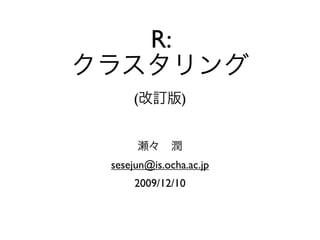Datamining R 5th
- 1. R:
( )
sesejun@is.ocha.ac.jp
2009/12/10
- 3. > usps.dist<-dist(usps.sub, method="euclidean")
> usps.dist
img_0_00_00 img_1_00_00 img_2_00_00 img_3_00_00
img_1_00_00 2517.392
img_2_00_00 2172.201 2204.662
img_3_00_00 2073.739 2128.806 2225.389
img_4_00_00 2239.165 1915.576 2220.492 1928.101
img_5_00_00 1981.039 2472.299 2179.280 2400.684
...
> usps.hclust<-hclust(usps.dist,method="single")
> plot(usps.hclust)
- 7. 1. k-means usps_cluster_large.tab k
k 5
• usps_cluster_large.tab 0 9 5 50
2. DIANA
usps_cluster_large.tab
• 1,2
3.
• 1 29
